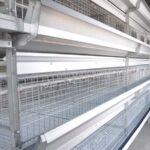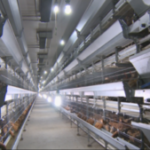Important advice on raising broiler chicken in cages
In recent years, the broiler industry has developed rapidly, the level of standardization has been greatly improved, and the breeding method has gradually shifted to cage breeding, which has doubled the scale of space breeding. Broiler chicken cages have many advantages, and there are also many points that need attention.
- Feeding
It is best to load every morning, and the automatic feeding machine’s 3 times a day is ideal. If using a trough, manual feeding must be added evenly. And to feed them in time to prevent the chickens from being trampled on due to hunger. The breeder checks whether there are empty troughs every afternoon and feeds them in time. Technicians should check the feeding situation of the feed trough every day. If there is too much material, they should analyze and judge the possible situation in time: whether there are few chickens in the cage and should be refilled in time; whether the nipples are lack of water; whether there are sick chickens in the cage, should Pick out individual treatments or eliminate them in time; whether the daylight is insufficient, and adjust in time.
- Temperature
The temperature should be constant and the transition should be smooth. The brooding temperature is generally 33-35°C. According to this benchmark. As the chickens grow older. It drops twice a week, not hot and cold. Technicians and breeders should always pay attention to weather changes, keep abreast of the outside temperature, and appropriately adjust the ventilation volume according to the required temperature. In winter, the boiler should be guaranteed to work normally, and there should be no omissions during the period. To prevent high temperature and heatstroke in summer, especially for chickens after 30 days, it is very important to activate the wet curtain in time. Cooling equipment must be equipped when the ambient temperature exceeds 33°C.

- Humidity
The management of humidity cannot be neglected during the breeding process. Suitable humidity is conducive to the normal growth of broilers. If the humidity is too low, it is easy to cause dehydration of broiler chickens, poor feather growth, dry skin, dust in the air, bacteria and viruses are usually attached to the dust, and it is easy to induce respiratory diseases. Excessive humidity can easily breed bacteria. If there is insufficient humidity in the house, use warm water spray to disinfect the chickens; if the humidity exceeds 70%, increase the temperature while appropriately increasing the ventilation.
- Ventilation
The cage mode is three-dimensional aquaculture with high density in the unit space, so ventilation is an important part of the breeding process. Through the rational allocation of ventilation facilities, sufficient fresh air is provided, the accumulation of pathogenic microorganisms in the chicken house is reduced, and the healthy growth of the chicken flock is ensured. Chicken coops generally need skylights, side windows, and longitudinal fans, which are the basic conditions for good ventilation. According to the season, outside temperature, indoor air quality, and the amount of ventilation required, a speed regulator should be installed, and the fan speed and duration will vary according to circumstances to prevent excessive air flow from causing a cold. When the wet curtain is activated in summer, the air inlet must be covered, and cold wind is strictly forbidden to blow directly on nearby chickens. When the weather changes suddenly and strong winds come up, close the side windows temporarily.
The above is the suggestion for chicken battery cages. It can not only make full use of the building space and reduce the space for each chicken, but also will be an important direction for the development of the broiler industry in the future, and it is worthy of vigorous promotion and practical innovation.











